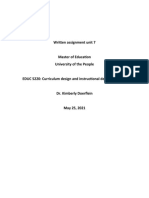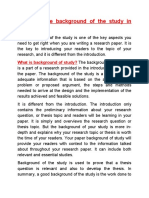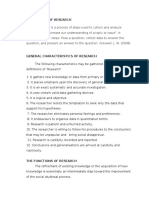Case Study
Uploaded by
Dhiraj LekhrajaniCase Study
Uploaded by
Dhiraj LekhrajaniA process or record of research in which detailed consideration is given to the development of a particular person, group, or situation over a period
of time A particular instance of something used or analyzed in order to illustrate a thesis or principle
According to cite{Fenton&Pfleeger1997}, a case study is a research technique where you identify key factors that may affect the outcome of an activity and then document the activity: its inputs, constraints, resources, and outputs.
A case study is one of several ways of doing research whether it is social science related or even socially related. It is an in-depth investigation/study of a single individual, group, incident, or community.
The case study method of teaching used in management education is quite different from most of the methods of teaching used at the school and undergraduate course levels. Unlike traditional lecture-based teaching where student participation in the classroom is minimal, the case method is an active learning method, which requires participation and involvement from the student in the classroom. For students who have been exposed only to the traditional teaching methods, this calls for a major change in their approach to learning.
There is no universally accepted definition for a case study, and the case method means different things to different people. Consequently, all case studies are not structured similarly, and variations abound in terms of style, structure and approach. Case material ranges from small case lets (a few paragraphs to one-two pages) to short cases (four to six pages) and from 10 to 18 page case studies to the longer versions (25 pages and above).
A case is usually a "description of an actual situation, commonly involving a decision, a challenge, an opportunity, a problem or an issue faced by a person or persons in an organization."1 In learning with case studies, the student must deal with the situation described in the case, in the role of the manager or decision maker facing the situation. An important point to be emphasized here is that a case is not a problem. A problem usually has a unique, correct solution. On the other hand, a decision-maker faced with the situation described in a case can choose between several alternative courses of action, and each of these alternatives may plausibly be supported by logical argument. To put it simply, there is no unique, correct answer in the case study method.
The case study method usually involves three stages: individual preparation, small group discussion, and large group or class discussion. Unlike lecture-based teaching, the case method requires intensive preparation by the students, before each class. If a case has been assigned for discussion in the class, the student must prepare carefully and thoroughly for the case discussion.
1. Gaining familiarity with the case situation (critical case facts, persons, activities, contexts) 2. Recognizing the symptoms (what are the things that are not as expected, or as they should be?) 3. Identifying goals/objectives 4. Conducting the analysis 5. Making the diagnosis (identifying problems, i.e., discrepancies between goals and performance, prioritizing problems etc.) 6. Preparing the action plan (identifying feasible action alternatives, selecting a course of action, implementation planning, plan for monitoring implementation)
A classroom case discussion is usually guided by the instructor. Students are expected to participate in the discussion and present their views. In some cases, the instructor may adopt a particular view, and challenge the students to respond. During the discussion, while a student presents his point of view, others may question or challenge him. Case instructors usually encourage innovative ways of looking at and analyzing problems, and arriving at possible alternatives.
The interaction among students, and between the students and the instructor, must take place in a constructive and positive manner. Such interactions help to improve the analytical, communication, and interpersonal skills of the students.
If a group of students is asked to analyze a case, they must ensure that they meet to discuss and analyze the case, by getting together for a group meeting at a suitable time and location. Before the meeting, all the team members must read the case and come with their own set of remarks/observations. The group must ensure that all the group members contribute to the preparation and discussion. It is important that the group is able to work as a cohesive team problems between team members are likely to have an adverse impact on the group's overall performance.
Quite often, a written analysis of the case may be a part of the internal evaluation process. When a written analysis of a case is required, the student must ensure that the analysis is properly structured.
An instructor may provide specific guidelines about how the analysis is to be structured. However, when submitting an analysis, the student must ensure that it is neat and free from any factual, language and grammar errors. In fact, this is a requirement for any report that a student may submit not just a case analysis.
The key to a good presentation is good preparation. If the case has been studied and analyzed thoroughly, the content of the presentation should present no problems. However, a presentation is more than the content. Some of points that need to be kept in mind when making a case presentation are: As far as possible, divide the content uniformly so that each team member gets an opportunity to speak. Use visual aids such as OHP slides, Power Point presentations, advertisement/press clippings etc., as much as possible. Be brief and to-the-point. Stick to the time limits set by the instructor. Be well prepared.
Benefits from the Case Method The case benefit has several advantages over traditional teaching methods. Cases allow students to learn by doing. They allow students to step into the shoes of decision-makers in real organizations, and deal with the issues managers face, with no risk to themselves or the organization involved. Cases improve the students ability to ask the right questions, in a given problem situation. Their ability to identify and understand the underlying problems rather than the symptoms of the problems is also enhanced. Case studies expose students to a wide range of industries, organizations, functions and responsibility levels. This provides students the flexibility and confidence to deal with a variety of tasks and responsibilities in their careers. It also helps students to make more informed decisions about their career choices.
Cases studies strengthen the student's grasp of management theory, by providing real-life examples of the underlying theoretical concepts. By providing rich, interesting information about real business situations, they breathe life into conceptual discussions. Cases provide students with an exposure to the actual working of business and other organizations in the real world. Case studies reflect the reality of managerial decisionmaking in the real world, in that students must make decisions based on insufficient information. Cases reflect the ambiguity and complexity that accompany most management issues. When working on a case study in a group, students must also be able to understand and deal with the different viewpoints and perspectives of the other members in their team. This serves to improve their communication and interpersonal skills. Case studies provide an integrated view of management. Managerial decision-making involves integration of theories and concepts learnt in different functional areas such as marketing and finance. The case method exposes students to this reality of management.
You might also like
- Herb Dewey - Mindblowing Psychic Readings OCRd82% (11)Herb Dewey - Mindblowing Psychic Readings OCRd72 pages
- The Process of Conducting Research Using Quantitative and - Id.enNo ratings yetThe Process of Conducting Research Using Quantitative and - Id.en28 pages
- Commerce Education - Approaches Methods and Techniques of Teaching CommerceNo ratings yetCommerce Education - Approaches Methods and Techniques of Teaching Commerce15 pages
- List of Teaching Methodologies Primary School Your Guide To The Top Teaching Methodologies in Primary SchoolNo ratings yetList of Teaching Methodologies Primary School Your Guide To The Top Teaching Methodologies in Primary School10 pages
- Formative Assessmentand Monitoring Student ProgressNo ratings yetFormative Assessmentand Monitoring Student Progress6 pages
- Developing Critical Thinking Skills of Students in Mathematics LearningNo ratings yetDeveloping Critical Thinking Skills of Students in Mathematics Learning11 pages
- Literature Review On Teacher Retention and AttritionNo ratings yetLiterature Review On Teacher Retention and Attrition26 pages
- 09 - Data Analysis - Descriptive StatisticsNo ratings yet09 - Data Analysis - Descriptive Statistics23 pages
- Academic Engagement As A Mediator in Relationships Between Emotional Intelligence and Academic Achievement Among Adolescents in Kerman-IranNo ratings yetAcademic Engagement As A Mediator in Relationships Between Emotional Intelligence and Academic Achievement Among Adolescents in Kerman-Iran10 pages
- Assignment Home Based Activity For MAED: Cebu Technological University Cebu CityNo ratings yetAssignment Home Based Activity For MAED: Cebu Technological University Cebu City14 pages
- Monitoring and Evaluation of Non-Formal Education ProgrammeNo ratings yetMonitoring and Evaluation of Non-Formal Education Programme40 pages
- How To Write Background of The Study in ResearchNo ratings yetHow To Write Background of The Study in Research4 pages
- Difference Betwween Measurement and AssessemntNo ratings yetDifference Betwween Measurement and Assessemnt1 page
- Personal Teaching Philosophy - Samantha BehrensNo ratings yetPersonal Teaching Philosophy - Samantha Behrens4 pages
- The Effect of Teachers Teaching Style and Students MotivationNo ratings yetThe Effect of Teachers Teaching Style and Students Motivation7 pages
- Performance-Based Assessment: Prepared By: Kerwin D. PalpalNo ratings yetPerformance-Based Assessment: Prepared By: Kerwin D. Palpal13 pages
- Roles of Assessment in The Teaching of SocialNo ratings yetRoles of Assessment in The Teaching of Social50 pages
- Megan Stone-Direct Lesson-3 Branches of GovernmentNo ratings yetMegan Stone-Direct Lesson-3 Branches of Government4 pages
- How To Write Chapter 3-Methods of Research and Procedures100% (1)How To Write Chapter 3-Methods of Research and Procedures17 pages
- Lecture 2 - Meaning of Educational Research100% (1)Lecture 2 - Meaning of Educational Research2 pages
- Duties and Resposibilities of A TeachersNo ratings yetDuties and Resposibilities of A Teachers6 pages
- PBL Essential Elements Checklist: Does The Project ?100% (1)PBL Essential Elements Checklist: Does The Project ?3 pages
- Teaching Strategies Preferred Most by The BSHRM Students of CDDNo ratings yetTeaching Strategies Preferred Most by The BSHRM Students of CDD16 pages
- U of H Open Records Complaint To Texas Attorney GeneralNo ratings yetU of H Open Records Complaint To Texas Attorney General21 pages
- Damage To Genital Tract, Tears, Uterine Rupture, Episiotomy, Shock in ObstetricsNo ratings yetDamage To Genital Tract, Tears, Uterine Rupture, Episiotomy, Shock in Obstetrics12 pages
- CE8394 Fluid Mechanics and Machinery MCQNo ratings yetCE8394 Fluid Mechanics and Machinery MCQ39 pages
- 4G Single Radio Access Network (SRAN) : Course Code: TRC-830No ratings yet4G Single Radio Access Network (SRAN) : Course Code: TRC-8303 pages
- Practice Questions - Aggregate Supply Andn Demand - Answer KeyNo ratings yetPractice Questions - Aggregate Supply Andn Demand - Answer Key5 pages
- The Process of Conducting Research Using Quantitative and - Id.enThe Process of Conducting Research Using Quantitative and - Id.en
- Commerce Education - Approaches Methods and Techniques of Teaching CommerceCommerce Education - Approaches Methods and Techniques of Teaching Commerce
- List of Teaching Methodologies Primary School Your Guide To The Top Teaching Methodologies in Primary SchoolList of Teaching Methodologies Primary School Your Guide To The Top Teaching Methodologies in Primary School
- Formative Assessmentand Monitoring Student ProgressFormative Assessmentand Monitoring Student Progress
- Developing Critical Thinking Skills of Students in Mathematics LearningDeveloping Critical Thinking Skills of Students in Mathematics Learning
- Literature Review On Teacher Retention and AttritionLiterature Review On Teacher Retention and Attrition
- Academic Engagement As A Mediator in Relationships Between Emotional Intelligence and Academic Achievement Among Adolescents in Kerman-IranAcademic Engagement As A Mediator in Relationships Between Emotional Intelligence and Academic Achievement Among Adolescents in Kerman-Iran
- Assignment Home Based Activity For MAED: Cebu Technological University Cebu CityAssignment Home Based Activity For MAED: Cebu Technological University Cebu City
- Monitoring and Evaluation of Non-Formal Education ProgrammeMonitoring and Evaluation of Non-Formal Education Programme
- The Effect of Teachers Teaching Style and Students MotivationThe Effect of Teachers Teaching Style and Students Motivation
- Performance-Based Assessment: Prepared By: Kerwin D. PalpalPerformance-Based Assessment: Prepared By: Kerwin D. Palpal
- Megan Stone-Direct Lesson-3 Branches of GovernmentMegan Stone-Direct Lesson-3 Branches of Government
- How To Write Chapter 3-Methods of Research and ProceduresHow To Write Chapter 3-Methods of Research and Procedures
- PBL Essential Elements Checklist: Does The Project ?PBL Essential Elements Checklist: Does The Project ?
- Teaching Strategies Preferred Most by The BSHRM Students of CDDTeaching Strategies Preferred Most by The BSHRM Students of CDD
- U of H Open Records Complaint To Texas Attorney GeneralU of H Open Records Complaint To Texas Attorney General
- Damage To Genital Tract, Tears, Uterine Rupture, Episiotomy, Shock in ObstetricsDamage To Genital Tract, Tears, Uterine Rupture, Episiotomy, Shock in Obstetrics
- 4G Single Radio Access Network (SRAN) : Course Code: TRC-8304G Single Radio Access Network (SRAN) : Course Code: TRC-830
- Practice Questions - Aggregate Supply Andn Demand - Answer KeyPractice Questions - Aggregate Supply Andn Demand - Answer Key

























































































